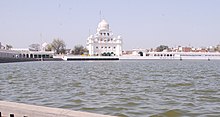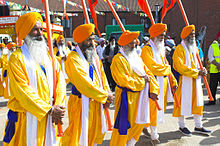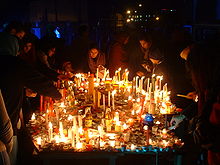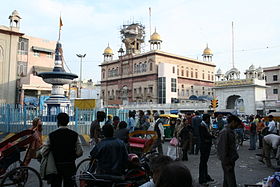Праздники сикхов
Сикхские праздники часто отмечаются тогда же, когда и индуистские, но отражают совершенно иной подход. Это время для спокойной медитации перед «Гуру Грант Сахибом», но при этом — и время кипучей деятельности. Для сикхских праздников характерны спортивные соревнования, показательные конные скачки, состязания в насмешничестве, фейерверки и обильные лангары. В главных гурдварах загораются тысячи электроламп, и громадные шествия заполняют улицы главных индийских городов. В Дели на день рождения Гуру Нанака сикхи украшают до десяти километров дороги, а сами процессии могут быть еще на два-три километра длиннее.
Все сикхские праздники открываются чтением полного текста «Гуру Грант Сахиба», что занимает около 48 часов. Некоторые приходят, чтобы послушать чтение только части книги, называемой Путь Аканд.
Сикхи, носящие пять К, готовятся к церемонии инициации. Для этой церемонии, а также для переноски «Гуру Грант Сахиба», требуются пятеро сикхов, представляющих Пандж Пьяри, «пятерых возлюбленных» — пятерых первых добровольцев Хелсы
Байсакхи (13 апреля). Праздник Байсакхи, изначально — праздник урожая, привязан к солнечному календарю и лишь очень редко отмечается 14 апреля. Он посвящен основанию Хелсы. Обычно в этот же день новые члены вступают в нее. На этот праздник флаг, который реет перед каждым храмом, спускают, моют флагшток и с молитвами водружают новое полотнище.
Мученичество Гуру Арджана Дева (4 число месяца Джайстха). Время горя и радости. Происходят обычные церемонии чтения «Гуру Грант Сахиба» и проведения шествий, но при этом особо подчеркивается необходимость помнить тех, кто пострадал за свою веру.
Дивали (четырехдневный праздник, заканчивается на второй день Картика).
Опять же он выпадает на то же время, что и индуистский праздник Дивали. Сикхи зажигают огни в своих домах, чтобы отметить освобождение из тюрьмы Гуру Харгобинда, которого вместе с пятьюдесятью двумя индийскими принцами заточил император Джехангир. Император предложил освободить Гуру Харгобинда, но тот отказался покинуть тюрьму, пока принцы тоже не будут отпущены. На Дивали загорается иллюминация в Доме Бога (Золотой храм) в Амритсаре, устраиваются фейерверки и уличные шествия.
День рождения Гуру Нанака (полная луна Картика). Рассказываются истории о Гуру Нанаке, а в гурдварах распевают его гимны. Во многих уголках Индии по улицам, украшенным по этому случаю, шествуют процессии.
Хола Мохалла (день полнолуния Фалгуна). Приходится на тот же день, что и индуистский праздник Холи, но индуисты отмечают этот праздник играми и розыгрышами, а сикхи устраивают атлетические и конные состязания и соревнования по боевым искусствам. Самые грандиозные из них проводятся в Анандпуре, месте основания Хелсы.
Поделиться ссылкой
У сикхов распространены праздники, связанные с годовщинами рождения или смерти почти всех их гуру. Некоторые из этих дат отмечаются пышно, другие более скромно — в зависимости от традиций, сложившихся в той или иной местности или храме. Эти праздники носят название Гурпураб. В такие дни храмы-гурудвары украшают цветами, проходят торжественные чтения священной «Ади Грантх», послушать которые собираются толпы людей в праздничных одеждах. С полной нагрузкой работают трапезные, где по случаю празднеств готовят специальные сладкие блюда. Только в такие дни сикхи пьют бханг — напиток на основе индийской конопли; её перебродивший сок, смешанный с водой, даёт наркотический эффект.
Одним из самых ярких праздников является Байсакхи — день рождения хальсы, coвпадающий с первым днём месяца басакх (апрель — май) по индийскому календарю *в основном попадает на 13-е апреля каждого года). Этот праздник отмечается в течение нескольких дней. Байсакхи называют праздником весны, когда в Индии после прохладных зимних месяцев и в преддверии сильнейшей жары всё пышно расцветает.
Центрами торжеств обычно становятся храмы. В эти дни устраиваются ярмарки, в том числе и ярмарки скота. И поскольку Байсакхи — это «день хальсы», то повсюду проводятся воинские игры, соревнования воинов-общинников, т. е. «истинных сикхов». Предшествует играм торжественная процессия, возглавляемая предводителем общины,который едет обычно на празднично наряженном слоне. Его окружают конные всадники, а за ними следуют пешие сикхи во главе с пятью избранными — наиболее уважаемыми людьми в общине.
Вся процессия гремит, звенит, сверкает оружием кинжалами, мечами, копьями. Каждый общинник буквально увешан оружием с головы до ног. Участники процессии заходят в храм, а затем, как бы получив благословение Bсевышнего, устремляются к месту проведения соревнований. Там иногда исполняются короткие боевые ритуальные танцы, произносятся молитвы во славу оружия, а потом…
Потом выплёскиваются вся горячность и неуёмная энергия сикхов, их стремление продемонстрировать свои воинские навыки, усиленное возбуждающим действием бханга. Они соревнуются в джигитовке, в умении владеть всеми мыслимыми видами оружия. Состязание сикхов, вспыльчивых по натуре, разгорячённых атмосферой соревнования и праздника, — захватывающее зрелище.
Сикхи празднуют также следующие дни:
-
День принятия Святого Гранта как Духовного руководителя
-
Дни мученика известных Сикхов, которые умерли ради спасения своей религии и выступившие в защиту угнетенных
-
Дни, связанные с важными событиями истории
Сикхские праздники — памятные случаи, отмечаемые поклонением и празднествами, такими как парады. Гуру Грантх Сахиб, писание сикхизма, проходит по улицам на паланкине или плавает в музыкальной процессии, известной как нагар киртан, которая включает в себя преданное пение. Пандж-пьяра, или пять любимых, идут впереди молящихся. Могут быть поплавки, представляющие сцены из истории или несущие преданных. Много раз будут демонстрации боевых искусств, известные как гатка. Традиционно, лангар, бесплатная еда и напитки, доступны на параде, маршруте или подаются по его окончании.
Важные даты и календарь Нанакшахи

Сикхские празднования отмечают важные события в истории сикхов. Сикхизм восходит к 1469 году нашей эры и берет свое начало в Пенджабе 15-го века. Непонятные записи, датированные согласно лунным календарям Пенджаба, использовавшиеся столетия назад, транскрибируются, чтобы совпадать с современными солнечными индийскими календарями и адаптируются к западно-григорианскому календарю. Даты различаются в каждом последующем году и могут привести к путанице. Календарь Nanakshahi, разработанный в 20-м веке, соответствует названиям месяцев, которые появляются в Guru Granth Sahib. Памятные события привязаны к стандартизированному западному календарю, так что они могут отмечаться во всем мире в одну и ту же дату год за годом. Тем не менее, празднования могут происходить за недели, предшествующие данной дате.
Ваисахи, годовщина посвящения

Vaisakhi — это ежегодное празднование, которое происходит в апреле 1699 года. Vaisakhi отмечает годовщину того, как Гуру Гобинд Сингх официально оформил членство в сикхской религии с помощью обрядов посвящения. Гуру призвал добровольцев, готовых отдать свои головы. Пятеро, кто вышел вперед, известны как Пандж Пяре, или пять любимых. Пяндж Пяре проводит церемонию посвящения, известную как Амритсанчар. Посвященный пьет Амрит, бессмертный нектар. Поминальные службы могут включать пересказ этого события, повествование о битвах, в которых участвовал Гуру Гобинд Сингх, преданное пение, парады нагар киртан и церемонии посвящения в Амрит.
Значение Пяндж Пяре в торжествах

Пандж-пьяра — представители пяти исторических возлюбленных администраторов Амрита. Все важные сикхские праздники и праздники проводятся с участием панджпяры. Во многих случаях, особенно на парадах, могут присутствовать несколько групп из пяти сикхов. Пандж-пяра традиционно носит шафрановые чоли, носит мечи и идет во главе процессии. Другие группы по пять человек могут нести флаги штатов и федерации, флаги Нишан-Сахиб-сикхов или плакаты и могут носить (как группа) желтый шафран, ярко-оранжевый, синий или белый.
Привет Мохалла, парад сикхских боевых искусств

Ежегодное мероприятие Hola Mohalla — парад боевых искусств, исторически совпадающий с Holi, индуистским фестивалем красок, который проходит в марте. Празднование Хола Мохалла в Пенджабе традиционно проводится в течение недели с парадом в последний день. Празднества включают демонстрации и демонстрации мастерства с участием Гатки, игры на мечах сикхских боевых искусств, и могут включать в себя другие умения, такие как верховая езда. В США Хола Мохалла принимает форму парада нагар киртан с демонстрацией гатки, сикхского боевого искусства. Эти мероприятия могут проводиться в разных местах в течение нескольких выходных, предшествующих фактической дате праздника.
Банди Чхор, Освобождение от заключения

Банди Чхор — это памятное событие, не имеющее фиксированной даты, которое происходит в октябре или ноябре, и празднует освобождение Шестого Гуру Хар Говинда из заключения. Событие исторически совпадает с Дивали, индуистским фестивалем ламп. Сикхи празднуют Банди Чхор богослужениями, которые включают киртан или религиозное пение и, возможно, зажигание ламп или свечей.
Гуру Гади Дивас, Праздник Инаугурации

Каждый из десяти гуру или духовных мастеров сикхизма был открыт по очереди. Гуру Гади Дивас — это праздник, посвященный инаугурации Гуру Грантх Сахиба как вечного Гуру сикхов 20 октября 1708 года. Гуру Гади празднуется как ежегодное мероприятие в конце октября — начале ноября. Сикхские преданные проводят парады с Гуру Грантх Сахибом по улицам на вершине поплавка или несут их на плечах в паланкине.
Гурпураб, рождение, инаугурация или мученичество десяти гуру
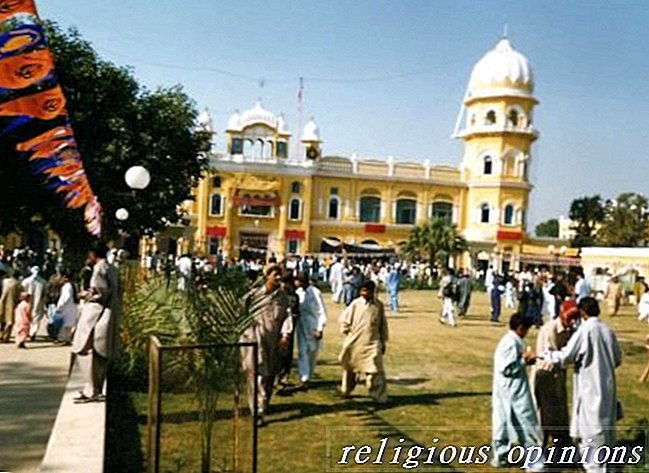
Гурпураб — это годовщина важных событий в жизни каждого из десяти гуру, которые включают в себя:
- рождения
- инаугурация
- Мученичество или смерть.
Такие случаи наблюдаются с богослужениями и религиозным пением.
- Гурпураб Гуру Нанака празднуется во время пура-маси, полной луны, в конце ноября или начале декабря. Этот праздник часто длится несколько дней и ночей и может включать в себя:
- Акханд паат, полное чтение Священных Писаний от Гуру Грантха.
- Киртан, или преданное пение.
- Rainsabaee, или всю ночь киртан
- Нагар киртан парады.
- Фейерверк.
- Рождение Гуру Гобинда Сингха и шахид или мученичество его четырех сыновей наблюдаются во время зимних каникул в конце декабря, когда Рэйнсабаи киртан поклоняется всю ночь.
Празднование жертвоприношения шахидов-сингхов (сикхских мучеников)

Празднование Шахиди — это памятные мероприятия, посвященные жертвоприношению сикхских мучеников. Услуги по организации празднования включают программы Rainsabaee для ночных киртанов. Шахиды включают, но не ограничиваются:
- Гуру Арджан Дев и его трое учеников.
- Гуру Хар Кришан.
- Гуру Тег Бахадур.
- Старейшина Сахибзаде Десятый старший сын Гуру.
- Младший Сахибзада (сыновья) и мать Гуру Гобинд Сингха.
- Гуру Гобинд Сингх.
- Сорок освобожденных.
- Женщины и дети, заключенные и подвергнутые пыткам.
- Бхай Мани Сингх, расчлененный.
- Бхай Тару Сингхоскальпед жив.
- 25 000 жертв Великого Холокоста 1762 года.
- Мученики, которые остановили поезд Панджа Сахиб в 1922 году.
- Тринадцать мучеников, в том числе Бхай Фауджа Сингх, отстаивавший честь Гуру Грантх Сахиб в 1978 году.
- Жертвы вторжения 1984 года в Золотой Храм и беспорядки в Дели.
Традиция Лангара в торжествах

Langar, услуга бесплатной вегетарианской еды и питья, является элементом, связанным с каждым и любым сикхским событием и событием, будь то богослужение, церемония, празднование или праздник. Традиционно лангар готовится на бесплатной кухне гурдвары и подается в столовой. Тем не менее, во время парада лангар может распространяться любым количеством способов. Преданные-сикхи могут раздавать предложения специально приготовленных блюд или раздавать расфасованные закуски и напитки по маршруту парада.
From Wikipedia, the free encyclopedia
(Redirected from Sikh Festivals)
This is the list of festivals observed by the followers of the Sikh religion.
| Festival | Date Observed | Description |
|---|---|---|
| Maghi and Mela Maghi | January 14 |
Gurudwara Muktsar Sahib This festival commemorates the Battle of Muktsar and was initially chosen by Sri Guru Amar Das Ji for Sikhs to attend the Gurdwara. |
| Parkash Utsav Dasmeh Patshah Sri Guru Gobind Singh Ji | January 5 | This festival’s name, when translated, means the birth celebration of the 10th Divine Light, or Divine Knowledges. It commemorates the birth of Guru Gobind Singh, the tenth Sikh guru. The festival is one of the most widely celebrated event by Sikhs. |
| Sikh New Year | March 13 or 14 | The Sikh new year in accordance to the Sikh Calendar (Nanakshahi Calendar). |
| Holla Mohalla | March |
A young Sikh performer at Holla Mohalla An annual festival of thousands held at Anandpur Sahib. It was started by Guru Gobind Singh as a gathering of Sikhs for military exercises and mock battles. The mock battles were followed by kirtan and valour poetry competitions. Today the Nihang Singhs carry on the martial tradition with mock battles and displays of swordsmanship and horse riding. There are also a number of darbars where kirtan is sung. It is celebrated by Sikhs across the world as ‘Sikh Olympics’ with events and competitions of swordsmanship, horse riding, Gatka (Sikh martial arts), falconry and others by Nihang Singhs. |
| Vaisakhi | April 14 |
Vaisakhi at Takht Sri Keshgarh Sahib at Anandpur Sahib, the birthplace of the Khalsa Panth In Punjab it is celebrated as the Birth of the Khalsa brotherhood. It is celebrated at a large scale at Kesgarh Sahib, Anandpur Sahib. In India, U.K., Canada, United States, and other Sikh populated areas, people come together for a public mela or parade. The main part of the mela is where a local Sikh Temple (Gurdwara) has a beautiful Sikh themed float on which the Guru Granth Sahib is located and every one offers their respect by bowing with much reverence and fervour. To mark the celebrations, Sikh devotees generally attend the Gurudwara before dawn with flowers and offerings in hands. Processions through towns are also common. Vaisakhi is the day on which the Khalsa was born and Sikhs were given a clear identity and a code of conduct to live by, led by the 10th Sikh Guru, Guru Gobind Singh Ji, who baptized the first Sikhs using sweet nectar called Amrit.[1] |
| Martyrdom of Guru Arjan | June 16 |
Panj Pyare, leading a procession of nagar kirtan marking the Shaheedi divas (martyrdom) The martyrdom anniversary of Guru Arjan, the fifth Guru, falls in June, the hottest month in India. He was tortured to death under the orders of Mughal Emperor, Jahangir, on the complaint of a Hindu banker Chandu Lal, who bore a personal enmity with Guru, at Lahore on 25 May 1606. Celebrations consist of Kirtan, Katha and Langar in the Gurdwara. Because of hot summer, chilled sweetened drink made from milk, sugar, essence and water is freely distributed in Gurdwaras and in neighborhoods to everybody irrespective of their religious belief as a sign and honour of the humble Guru who happily accepted his torture as a will of Waheguru and made no attempt to take any action. |
| Pahila Prakash Sri Guru Granth Sahib Ji | September 1 |
A copy of Guru Granth Sahib, the eternal Sikh Guru It is the day when the Guru Granth Sahib was bestowed with the title of being the eternal and final Sikh guru thus ending the line of Human gurus. |
| Bandi Chhor Divas | October 27 |
Diwali celebrations in United Kingdom. On the day of Bandhi Chhor Diwas (The Celebration of Freedom), Sikhs celebrate the release from prison of the sixth guru, Guru Hargobind, who also rescued 52 Hindu kings held captive by Mughal Emperor Jehangir with him in the Gwalior Fort in 1619. The Sikhs celebrated by lighting their homes with lights and candles with the tradition continuing till date with Harmandir Sahib beautifully decorated with colourful lights to mark this celebration. It is celebrated by lighting divas and going to a Gurdwara to listen to gurbani. |
| Guru Nanak Gurpurab | November 15 | On this day Guru Nanak was born in Nanakana Sahib, now situated in Pakistan. Every year Sikhs celebrate this day with large-scale gatherings. Candles, divas and lights are lit in Gurdwaras, in the honour of Guru along with fireworks. The birthday celebration usually lasts three days. Generally two days before the birthday, Akhand Path (forty-eight-hour non-stop reading of Guru Granth Sahib) is held in the Gurdwara. One day before the birthday, a procession is organized which is led by the Panj Pyares (Five Beloved Ones) and the Palki (Palanquin) of Sri Guru Granth Sahib and followed by teams of Ragis singing hymns, brass bands playing different tunes and devotees singing the chorus.
Gurdwara Nankana Sahib, Pakistan A fireworks show celebrating the Birth of Guru Nanak in India. Akal Takht illuminated on Guru Nanak Jayanti, in Harmandir Sahib complex, Amritsar. |
| Martyrdom of Guru Tegh Bahadur | November 24 | On this day Guru Tegh Bahadur was martyred when he refused to convert to Islam.
Gurdwara Sis Ganj Sahib where the Guru was martyred The Mughal Emperor, Aurangzeb cherished the ambition of converting India into a land of Islam. A group of Kashmiri Pandits (Kashmiri Hindu Brahmins), approached Guru Tegh Bahadur and asked for his help. They, on the advice of the Guru, told the Mughal authorities that they would willingly embrace Islam if Guru Tegh Bahadur, did the same.[2][3] Gurudwara Sisganj Sahib in Anandpur Sahib where the head of guru was brought and cremated in defiance of Mughals Orders of the arrest of the Guru were issued by Aurangzeb and the Guru was arrested at a place called Malikhpur near Anandpur after he had departed from Anandpur for Delhi. He was arrested, along with some of his followers and sent to Sirhind the following day. The Governor ordered him to be detained in Bassi Pathana and reported the news to Delhi. His arrest was made in July 1675 and he was kept in custody for over three months. He was then cast in an iron cage and taken to Delhi in November 1675. |
| Martyrdom Of the Sahibzade | December 21 and 26 | The Martyrdom of both the elder and younger Sahibzadas is a remembrance of the four young princes (sons of Guru Gobind Singh) who were martyred in late December. The two older sons, Sahibzade Ajit Singh and Jujhar Singh, were killed by Mughal soldiers during the battle of Chamkaur.[citation needed] Both the younger sons Sahibzade Zorawar Singh and Fateh Singh, were executed after being captured.[4] These Martyrs are observed 21 December and 26 December respectively. |
Other Sikh festivals[edit]
There are some other (around 45) festivals that are celebrated at a much smaller scale with some being centred in particular regions or towns that are not included in the above list. Thoses include Parkash Utsavs (Birth anniversaries of the other 8 Sikh gurus), Gurgadi Divas (passing of guruship), Jyotijot Divas (death anniversaries of other Sikh gurus), Basant Festival of kites which is celebrated in Chheharta Sahib Gurdwara in the village of Wadali where Sri Guru Hargobind Ji was born in 1595, to celebrate the birth and [5] many other such festivals. All Sikh festival include celebrating by gathering at Gurdwara, paying obeisance to the Guru Granth Sahib and listening to Gurbani, Kirtan and reciting Paath.
However, there are quite a few other local fairs which are historically important to the Sikhs and attract crowds in hundreds of thousands and last two to three days. The most important of these are:
- The Martyrdom of both the younger Sahibzadas of Guru Gobind Singh at Fatehgarh Sahib.
- The Battle of Chamkaur and the Martyrdom of both elder Sahibzadas of Guru Gobind Singh.
- The Martyrdom of the forty followers(«Forty Immortals») of Guru Gobind Singh who had previously deserted him, fought bravely against overwhelming Mughal army forces in Muktsar. Guru Gobind Singh blessed them as having achieved liberation. Mela Maghi commemorates this event and an annual fair is held in Sri Muktsar Sahib town.
See also[edit]
- Punjabi festivals
- Punjabi festivals in Pakistan
References[edit]
- ^ «Sikhism holy days: Baisakhi». BBC. Retrieved 2007-07-08.
- ^ a b «Sri Guru Tegh Bhadur Sahib Ji p2 | Sikh Gurus :Gateway to Sikhism». Archived from the original on 2009-10-09. Retrieved 2011-10-09.
- ^ a b Surinder Singh Kohli. 1993. The Sikh and Sikhism. P.78-89
- ^ «Zorawar Singh and Fateh Singh».
- ^ Johar, Surinder Singh Holy Sikh Shrines
External links[edit]
Media related to Sikh festivals at Wikimedia Commons
From Wikipedia, the free encyclopedia
(Redirected from Sikh Festivals)
This is the list of festivals observed by the followers of the Sikh religion.
| Festival | Date Observed | Description |
|---|---|---|
| Maghi and Mela Maghi | January 14 |
Gurudwara Muktsar Sahib This festival commemorates the Battle of Muktsar and was initially chosen by Sri Guru Amar Das Ji for Sikhs to attend the Gurdwara. |
| Parkash Utsav Dasmeh Patshah Sri Guru Gobind Singh Ji | January 5 | This festival’s name, when translated, means the birth celebration of the 10th Divine Light, or Divine Knowledges. It commemorates the birth of Guru Gobind Singh, the tenth Sikh guru. The festival is one of the most widely celebrated event by Sikhs. |
| Sikh New Year | March 13 or 14 | The Sikh new year in accordance to the Sikh Calendar (Nanakshahi Calendar). |
| Holla Mohalla | March |
A young Sikh performer at Holla Mohalla An annual festival of thousands held at Anandpur Sahib. It was started by Guru Gobind Singh as a gathering of Sikhs for military exercises and mock battles. The mock battles were followed by kirtan and valour poetry competitions. Today the Nihang Singhs carry on the martial tradition with mock battles and displays of swordsmanship and horse riding. There are also a number of darbars where kirtan is sung. It is celebrated by Sikhs across the world as ‘Sikh Olympics’ with events and competitions of swordsmanship, horse riding, Gatka (Sikh martial arts), falconry and others by Nihang Singhs. |
| Vaisakhi | April 14 |
Vaisakhi at Takht Sri Keshgarh Sahib at Anandpur Sahib, the birthplace of the Khalsa Panth In Punjab it is celebrated as the Birth of the Khalsa brotherhood. It is celebrated at a large scale at Kesgarh Sahib, Anandpur Sahib. In India, U.K., Canada, United States, and other Sikh populated areas, people come together for a public mela or parade. The main part of the mela is where a local Sikh Temple (Gurdwara) has a beautiful Sikh themed float on which the Guru Granth Sahib is located and every one offers their respect by bowing with much reverence and fervour. To mark the celebrations, Sikh devotees generally attend the Gurudwara before dawn with flowers and offerings in hands. Processions through towns are also common. Vaisakhi is the day on which the Khalsa was born and Sikhs were given a clear identity and a code of conduct to live by, led by the 10th Sikh Guru, Guru Gobind Singh Ji, who baptized the first Sikhs using sweet nectar called Amrit.[1] |
| Martyrdom of Guru Arjan | June 16 |
Panj Pyare, leading a procession of nagar kirtan marking the Shaheedi divas (martyrdom) The martyrdom anniversary of Guru Arjan, the fifth Guru, falls in June, the hottest month in India. He was tortured to death under the orders of Mughal Emperor, Jahangir, on the complaint of a Hindu banker Chandu Lal, who bore a personal enmity with Guru, at Lahore on 25 May 1606. Celebrations consist of Kirtan, Katha and Langar in the Gurdwara. Because of hot summer, chilled sweetened drink made from milk, sugar, essence and water is freely distributed in Gurdwaras and in neighborhoods to everybody irrespective of their religious belief as a sign and honour of the humble Guru who happily accepted his torture as a will of Waheguru and made no attempt to take any action. |
| Pahila Prakash Sri Guru Granth Sahib Ji | September 1 |
A copy of Guru Granth Sahib, the eternal Sikh Guru It is the day when the Guru Granth Sahib was bestowed with the title of being the eternal and final Sikh guru thus ending the line of Human gurus. |
| Bandi Chhor Divas | October 27 |
Diwali celebrations in United Kingdom. On the day of Bandhi Chhor Diwas (The Celebration of Freedom), Sikhs celebrate the release from prison of the sixth guru, Guru Hargobind, who also rescued 52 Hindu kings held captive by Mughal Emperor Jehangir with him in the Gwalior Fort in 1619. The Sikhs celebrated by lighting their homes with lights and candles with the tradition continuing till date with Harmandir Sahib beautifully decorated with colourful lights to mark this celebration. It is celebrated by lighting divas and going to a Gurdwara to listen to gurbani. |
| Guru Nanak Gurpurab | November 15 | On this day Guru Nanak was born in Nanakana Sahib, now situated in Pakistan. Every year Sikhs celebrate this day with large-scale gatherings. Candles, divas and lights are lit in Gurdwaras, in the honour of Guru along with fireworks. The birthday celebration usually lasts three days. Generally two days before the birthday, Akhand Path (forty-eight-hour non-stop reading of Guru Granth Sahib) is held in the Gurdwara. One day before the birthday, a procession is organized which is led by the Panj Pyares (Five Beloved Ones) and the Palki (Palanquin) of Sri Guru Granth Sahib and followed by teams of Ragis singing hymns, brass bands playing different tunes and devotees singing the chorus.
Gurdwara Nankana Sahib, Pakistan A fireworks show celebrating the Birth of Guru Nanak in India. Akal Takht illuminated on Guru Nanak Jayanti, in Harmandir Sahib complex, Amritsar. |
| Martyrdom of Guru Tegh Bahadur | November 24 | On this day Guru Tegh Bahadur was martyred when he refused to convert to Islam.
Gurdwara Sis Ganj Sahib where the Guru was martyred The Mughal Emperor, Aurangzeb cherished the ambition of converting India into a land of Islam. A group of Kashmiri Pandits (Kashmiri Hindu Brahmins), approached Guru Tegh Bahadur and asked for his help. They, on the advice of the Guru, told the Mughal authorities that they would willingly embrace Islam if Guru Tegh Bahadur, did the same.[2][3] Gurudwara Sisganj Sahib in Anandpur Sahib where the head of guru was brought and cremated in defiance of Mughals Orders of the arrest of the Guru were issued by Aurangzeb and the Guru was arrested at a place called Malikhpur near Anandpur after he had departed from Anandpur for Delhi. He was arrested, along with some of his followers and sent to Sirhind the following day. The Governor ordered him to be detained in Bassi Pathana and reported the news to Delhi. His arrest was made in July 1675 and he was kept in custody for over three months. He was then cast in an iron cage and taken to Delhi in November 1675. |
| Martyrdom Of the Sahibzade | December 21 and 26 | The Martyrdom of both the elder and younger Sahibzadas is a remembrance of the four young princes (sons of Guru Gobind Singh) who were martyred in late December. The two older sons, Sahibzade Ajit Singh and Jujhar Singh, were killed by Mughal soldiers during the battle of Chamkaur.[citation needed] Both the younger sons Sahibzade Zorawar Singh and Fateh Singh, were executed after being captured.[4] These Martyrs are observed 21 December and 26 December respectively. |
Other Sikh festivals[edit]
There are some other (around 45) festivals that are celebrated at a much smaller scale with some being centred in particular regions or towns that are not included in the above list. Thoses include Parkash Utsavs (Birth anniversaries of the other 8 Sikh gurus), Gurgadi Divas (passing of guruship), Jyotijot Divas (death anniversaries of other Sikh gurus), Basant Festival of kites which is celebrated in Chheharta Sahib Gurdwara in the village of Wadali where Sri Guru Hargobind Ji was born in 1595, to celebrate the birth and [5] many other such festivals. All Sikh festival include celebrating by gathering at Gurdwara, paying obeisance to the Guru Granth Sahib and listening to Gurbani, Kirtan and reciting Paath.
However, there are quite a few other local fairs which are historically important to the Sikhs and attract crowds in hundreds of thousands and last two to three days. The most important of these are:
- The Martyrdom of both the younger Sahibzadas of Guru Gobind Singh at Fatehgarh Sahib.
- The Battle of Chamkaur and the Martyrdom of both elder Sahibzadas of Guru Gobind Singh.
- The Martyrdom of the forty followers(«Forty Immortals») of Guru Gobind Singh who had previously deserted him, fought bravely against overwhelming Mughal army forces in Muktsar. Guru Gobind Singh blessed them as having achieved liberation. Mela Maghi commemorates this event and an annual fair is held in Sri Muktsar Sahib town.
See also[edit]
- Punjabi festivals
- Punjabi festivals in Pakistan
References[edit]
- ^ «Sikhism holy days: Baisakhi». BBC. Retrieved 2007-07-08.
- ^ a b «Sri Guru Tegh Bhadur Sahib Ji p2 | Sikh Gurus :Gateway to Sikhism». Archived from the original on 2009-10-09. Retrieved 2011-10-09.
- ^ a b Surinder Singh Kohli. 1993. The Sikh and Sikhism. P.78-89
- ^ «Zorawar Singh and Fateh Singh».
- ^ Johar, Surinder Singh Holy Sikh Shrines
External links[edit]
Media related to Sikh festivals at Wikimedia Commons


